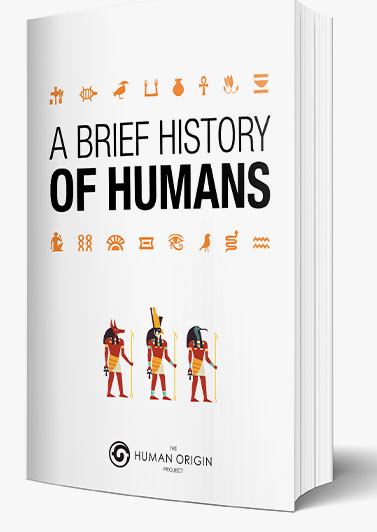The further back in time we go, the more enigmatic and unsure our history becomes. Our human origin story is still full of questions and mystery: Where did we come from? How did early civilizations turn into our modern society today?
One of the least understood chapters of this story, and probably the most important for us living in modern civilization, is how and why early civilizations began.
Why did they suddenly appear on different parts of the world at the same time? The time period around 3100 BC is perhaps one of the most important yet poorly understood for humankind.
Because of the antiquity of the first early civilizations, much of what we know has seemingly been lost; however, a comparative look at these early civilizations reveals an insight into our history that is as intriguing as it is mysterious.
In this article we’ll explore the language and history of earth’s early civilizations.
Four early kingships
Although agriculture had been happening on Earth for thousands of years, it was around 3100 BC that four kingships arose in separate locations on the planet. It was this period of self-sustaining culture that marks the beginnings of early civilizations as we think of them today.
As a period of history over 5000 years ago, much of the evidence we have has been confined to mythology and folklore. Only fragments of archaeological evidence survives this span of time. Piecing together a coherent story of the early civilizations has proven difficult for historians. While there is much to the story, we will follow these four early civilizations.
The first four agriculturally based kingships that appear on earth around 3100 BC are:
A look at the names of these locations in the ancient Egyptian language immediately draws interesting parallels through their phonetic spelling.
- Taru (Egypt)
- Aaru (Ireland)
- Yiru/iru (China)
- Peru (Peru)
The use of the Egyptian language as a starting point for comparing ancient cultures is assisted by the fact that there is plenty of physical evidence still standing today.
Thousands of ancient texts have been uncovered in Egypt as well as the deciphering of the highly advanced hieroglyphic language, all of which have helped researchers to piece together the connections between early civilizations.
Similar language between the Early Civilizations
One of the safest ways to compare cultures without the luxury of archaeological evidence is through the use of language. It is true that cultures rise and fall, yet words seem to have a way of sticking around. This is perfectly highlighted throughout the ancient Egyptian culture, which lasted continuously for more than 5000 years.
It has been well documented throughout all eras of Egypt’s long and prosperous history that similarly pronounced words maintained a similar meaning. The earliest of the Egyptian priests wrote of these linguistic similarities, and all of the later ones adopted this into their practices.
Just as this relates to ancient Egyptian culture, it is also true for ancient cultures that were completely isolated from Egypt geographically. And surprisingly, the further back in time we go, the more commonalities seem to appear.
Who did all of the ancient cultures adopt their language from? And how did this language spread so quickly across the planet during the era of 3100 BC?
Taru, Aaru, Iru (Yiru), and Peru and four cardinal directions
As we compare language, it is important to note that in ancient times, language was first and foremost phonetic. A modern example of this is found in the Spanish language, where words are pronounced exactly as they are spelled.
Remembering this, a comparison of the phonetics of the four early civilizations reveal correlations to the four cardinal points. Not only is this another link between the early civilizations, there are also similar phonetic titles found cross-culturally between them.
East and West
In the ancient Egyptian language, ‘ar’ translated to sunset, or the direction of west. This is phonetically similar to the ancient Gaelic word ‘Eire’ which also means west (and is the Gaelic name for Ireland.) As both of these words are pointing to the same direction and associated with the name ‘Aaru’, the ancient kingship of Ireland, a lingual connection between the separate cultures arises.
Not only is this the case, the term ‘ta’ implies east in the Egyptian culture which is the start of the word ‘Taru’, the name originally associated with Egypt. It was the quasi-mythical Egyptian god Osiris who referred to Abydos–the location in Egypt of the first Dynasty–as ‘the great land’ and named it ‘Taru,’ signifying the first agriculturally based kingship in the newly unified nation.
North and South
Along with these two directional names, the term ‘Pe’ or ‘Per’ in Egyptian translates to the word sky. To better understand this point it is important to remember that Egypt was originally split into regions known as Upper and Lower Egypt.
For reasons still not fully understood, when talking about these regions, common sense directions are reversed; the term Upper is actually referring to the region in the South, with Lower is referring to the North.
This brings us to the directional meaning of the ‘Pe’ in ‘Peru’ as south, which is geographically correct when compared to Egypt. ‘Yiru’ or ‘Iru’, the name for the early civilization located in China, was known through its name as North. The Egyptian word ‘aaa’ means earth and was associated with Lower Egypt.
Lion folklore across early civilizations
According to the Egyptian language, the names of these four early civilizations relate not only to each other, but also to the cardinal points. Here’s a look at the meaning of the second half of their names.
In the ancient Egyptian language, the term ‘ru’ translated to lion. This word makes up the second half of each of the names of the four early civilizations and is the most notable similarity to these cultures. What makes this even more interesting is the fact that the Egyptian language appears fully formed right at the time of their first dynasty at 3100 BC, meaning the names for these places existed since the earliest period of their civilization.
The Great Sphinx of Egypt is perhaps the greatest carved stone figure ever made by human hand and was without doubt extremely important in the Egyptian’s eyes. The half man, half lion sculpture has long been associated with the Egyptian culture and has symbolized their civilization since its beginnings.
Alongside this, many ancient cultures have the symbol of a lion relating to their earliest kingships. In China, the lion is a known symbol that has long been associated with the earliest of kingships at 3100 BC. Not only is this a similar outlook to the Egyptians, it is also true in Ireland – with lion symbolism present from archaic times all the way to the present day.
A literal translation of these names can now be interpreted as –
- Aaru, ‘Lion of the West’
- Taru, ‘Lion of the East’
- Yiru or Iru, ‘Lion of the North’
- Peru, ‘Lion of the South’
Commonalities between the Four Early Civilizations
- Egypt
Although historians disagree on the name, it is thought that the first Egyptian dynasty began around 3100 BC. This period in ancient times was when the regions known as Upper and Lower Egypt were unified and a culture of stable agriculture and living was established.
Through Egyptian language and hieroglyphs, commonalities appear between these early civilizations. Each also share the enigmatic nature in which the Egyptian civilization appears along with its counterparts.
- Ireland
The first signs of sophisticated farming, megalithic construction, and agricultural practices appear in the UK around 3200 BC on an island in Northern Scotland called Orkney Island. A Neolithic village settlement has been found there called Skara Brae, and has created more questions than answers for researchers.
What makes this ancient site so special is the fact that it is the first appearance of an agriculturally based kingship found in all of the UK. The little island inspired a flourish of similar farming, building, and living practices to follow suit across the entirety of the country. Although it has been so important in the story of the early civilizations of the UK, no one can agree on who the inhabitants were, what inspired them to commence civilization, and why they were in such a remote location.
There are not many texts left to us from this time throughout Ireland, however it was around 3200 BC that the earliest megalithic structures begin appearing across Ireland and the UK in general.
The most famous of these structures is Newgrange, located in the east of Ireland. The building of these sophisticated structures would only be possible by a culture possessing the luxury of a stable system of agriculture and farming able to generate a surplus of food for the workforce.
There are also similar carvings found at Newgrange that match those found in Egypt that relate to the area in which ‘Aaru’ (Ireland) was said to lie. This is yet another strange connection between these early civilizations.
- China
During the same time period that the first agriculturally based kingships begin to appear in China. It is thought that around 3000 BC the Yang Shao culture emerged, with evidence of large farming villages and pottery dating to this time.
Another link between ancient China and Egypt is the ‘well-field’ farming technique. It involves having nine plots of land laid out as a 3×3 grid. Each has a center plot used as a communal well. Not only was this system evident in China, it is still implemented by the modern day Dogon tribe of West Africa, who are thought to have descended from the Egyptians who were around during 3000 BC.
The most ancient and famous Chinese text is known as the Yijing or I-Ching (pronounced ‘eee’). It contains cosmological and ancient Chinese knowledge. Although this name is Chinese, it bears striking similarity to the Egyptian name for China, ‘Yiru’ or ‘Iru’. The similarity between these phonetics suggest that even in the oldest of times there was a connection between these distant civilizations.
- Peru
The first signs of advanced agriculture appear on the coast of Peru around 3100 BC. They were soon followed by megalithic constructions and organized civil states. From here advanced architecture, irrigation systems, and huge stone constructions were built.
All of these early civilizations attribute their beginnings to the implementation of agriculture and kingships, and Peru is no different. The term ‘Peru’ in ancient Egyptian means ‘men attached to the royal granary’, underlining the idea that stable agriculture and kingship signified the beginnings of civilization.
Along with this, the beginning of the Mesoamerican long count calendar that ended on 2012 started in 3114 BC – the time when Peruvian civilization appeared.
Conclusion
The more we learn about our ancient past, the more we reveal. Could there have been a connection between the four early civilizations?
Analysis of ancient language is a tool researchers will need to keep investigating. It’s crucial we continue to ask the right questions.
Now it’s up to you, what do you think? Is there a connection between these ancient cultures? And if so, could there have been an earlier culture that taught civilizing skills to these four early civilizations? Or did they simply appear by chance at the same time across the world?
Further reading:
The Mystery of Skara Brae by Laird Scranton


 There is a connection between ancient languages and four early civilizations of the four corners of the earth.
There is a connection between ancient languages and four early civilizations of the four corners of the earth. 
























